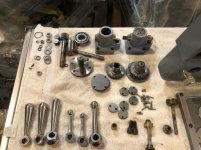Cal Haines
Diamond
- Joined
- Sep 19, 2002
- Location
- Tucson, AZ
If you're missing any, I have 21 "Rivett" 5Cs, mostly 1/16th series.
Cal
Cal
Follow along with the video below to see how to install our site as a web app on your home screen.
Note: This feature may not be available in some browsers.
Jon, regarding spare 6r collets, please take a look at my post where I list my extras and what I'm missing to see if any I need any of your extras.
Jeff in long beach
Ps. I thought you got a mix of hardinge and rivett?
Sent from my SM-G998U using Tapatalk

It's not super clear from the drawing if this bearing should have the retaining ring or not, can anyone clarify please?
-jon
I found bearings for my Rivett at EZ Bearing LLC. I talked to Darrel. Locate Ball Bearings also has these bearings and can save you money, but I’ve found that you need to be sure to check their condition.
I recommend setting the drive up on sawhorses, installing everything, hooking it up to electrical controls and running it there. It is much easier to adjust brake clearances and clutches while on stands. Also, I ended up having to reface my Reeves pulleys to eliminate a slight warpage. That required rebalancing. When you get everything they way you want it, pull it apart and repaint it. I installed my drive with a forklift.
The magnetic brake can be quieted if you regrind the magnet faces. Also, the Rivett’s Reeves drive is sensitive as to the brand of variable belts. It required four different ones before I found one that was both smooth and quiet. If you want, I can check what I used as I don’t recall it right now.



 seem to show another part there.
seem to show another part there.
note, all of the gears through out this machine look to have very little to no wear, which has me questioning the reasoning for a full disassembly
This was Carl Cederstrand's lathe? If so the reason the headstock was disassembled is because the iron casting inside the headstock was broken and he had to repair it.
Notice
This website or its third-party tools process personal data (e.g. browsing data or IP addresses) and use cookies or other identifiers, which are necessary for its functioning and required to achieve the purposes illustrated in the cookie policy. To learn more, please refer to the cookie policy. In case of sale of your personal information, you may opt out by sending us an email via our Contact Us page. To find out more about the categories of personal information collected and the purposes for which such information will be used, please refer to our privacy policy. You accept the use of cookies or other identifiers by closing or dismissing this notice, by scrolling this page, by clicking a link or button or by continuing to browse otherwise.
